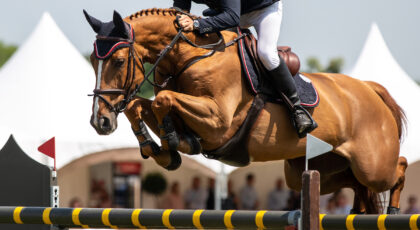I walked into the pasture and Jimbo, a 36-year-old Quarter Horse, came toward me with his hind end listing off to one side.
Then his hind end completely slipped out from under him and he spun around several times, nearly falling before heading off in a different direction using that strange listing, sideways walk.
After calling the vet and informing her I had an emergency, I switched to my cell phone’s camera. Jimbo was unstable, I was afraid he might fall on me if I got too close and figured the worst thing to do was put him in a stall, so I followed him around the pasture until the spinning began again. I made videos of his inability to control his hind end.
I called the owner and made sure she wasn’t driving before sending the video.
“The vet is on the way,” I added to the text.
The owner pulled up at the barn soon after and headed straight into the pasture to be with Jimbo.
When the vet arrived, I showed her the video.
“Spinning normally means something neurological,” she said.
We walked out to the pasture.
Jimbo was much better. No spinning. No hind end listing to the side. No crab walking. Other than some problems to be expected in a horse his age, the neurological exam, and every other check the vet performed, were within normal ranges.
The vet warned us, however, that given the spinning, Jimbo’s prognosis was poor. Within a week, he had to be euthanized. Ultimately, the vet diagnosed him with cervical (neck) arthritis that impinged on the nerves.
Months after we lost Jimbo, with a severe winter storm arriving, my 31-year-old mare came up lame. My husband led her around our indoor arena while I took videos of her from the back, front, and side. I texted them to my vet, who wouldn’t be able to get out to the farm for at least 24 hours, if not longer.
While the snow piled up outside, we began treatment of my mare.
Recently, Garnett, an 18-year-old Paint gelding, who has been treated for severe arthritis, multiple bowed tendons, and Lyme disease, began to crow hop on the front end when he got up every morning. No one was there to see it but me. I went out to the paddock early one morning and captured it on video.
Then there was the time an owner put ointment on her horse only to have the ointment burn and blister the horse’s skin.
You guessed it. I sent pictures to the vet and owner.
I’ve taken pictures of gashes, kicks, bites, hives, sarcoids, and swollen fetlocks. Sometimes I place a ruler beside the injury or sarcoid. If I’m rushed, I’ll include my fingers in the photo to give the injury or wound some perspective. I send the pictures to the vets and owners.

Photo courtesy of the author.
But I also use the pictures to track a horse’s recovery or decline.
Because I handle the horses every day, it can be difficult for me to see subtle changes so I regularly take pictures. Is the wound healing steadily? What did it look like three days ago? Has the swelling gone down in the leg? How ribby was the horse when he first arrived at the farm compared to now? On my phone, I have a pictorial record.
So get out your cell phone! It might be the most trustworthy tool you have to help you care for your horse.
About the Author
Nancy Hoffmann owns and manages a pleasure and retired horse farm in Maryland. Learn more at www.mistybluefarm.net.


 November 16, 2017
November 16, 2017 


























